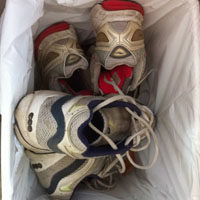 There always seems to be this hazy little cloud surrounding the word stretching. Is it really necessary? Does your body benefit from it? When are you supposed to do it, before or after the workout? This confusion causes many people to drop it from their workouts altogether. Well I implore you to bring it back! Stretching has many benefits and I will attempt to clarify when and how it should be done.
There always seems to be this hazy little cloud surrounding the word stretching. Is it really necessary? Does your body benefit from it? When are you supposed to do it, before or after the workout? This confusion causes many people to drop it from their workouts altogether. Well I implore you to bring it back! Stretching has many benefits and I will attempt to clarify when and how it should be done.
One way to reduce the cloudiness is to think of stretching like this: do dynamic stretching before your workout and a cooldown after your workout. Dynamic stretching uses speed of movement, momentum and active muscular effort to bring about a stretch. Unlike static stretching, the end position is not held, you are always moving. Think of arm circles or leg raises. You want to get the blood flowing to your muscles and tendons and raise up your body temperature. This initial warm-up should be modified moves of your workout. So if you’re going running, start with a light jog. Swimming, start with a few easy laps. Strength training, do large body part movements. This is more effective than starting out with static stretching, which can injure cold muscles and actually make them weaker before a workout. Dynamic stretching is like ballistic stretching yet without the bouncing moves which can easily lead to injury. The benefits of dynamic stretching are (and these are just a few):
- an increase in flexibility and joint range of motion
- correct exercise posture
- relaxed muscles
- better coordination
After your workout, your body needs to cooldown before you hit the showers. A cooldown can help your body recover faster. It can also:
- slow your heart rate to a normal speed
- return your breathing to its regular pace
- avoid stiffness and soreness of the muscles
- reduce any risk of dizziness and light-headedness
- relax the muscles
Spend 5 -10 minutes cooling down your body. Here is when you can incorporate static stretching since your body is already warmed up. Remember to breath while holding a stretch for 10-30 seconds. And if the stretch hurts, stop immediately. The more you stretch, the more flexible your body can become, and in the long run, flexibility can help keep you safe from injuries as you age.
Here are some dynamic exercises you can use before your workout:
Straight-Leg March (for the hamstrings and gluteus muscles)
Kick one leg straight out in front of you, with your toes flexed toward the sky. Reach your opposite arm to the upturned toes. Drop the leg and repeat with the opposite limbs. Continue the sequence for at least six or seven repetitions.
Handwalks (for the shoulders, core muscles, and hamstrings)
Stand straight, with your legs together. Bend over until both hands are flat on the ground. “Walk” your hands forward until your back is almost fully extended. Keeping your legs straight, inch your feet toward your hands, then walk your hands forward again. Repeat five or six times.
Arm Swings (for the shoulders, and core muscles)
Stand tall and hold arms out to your side. Slowly swing your arms back and forth across the front of your body. Repeat this continuous motion for 30 seconds.
Side Bends (for the core muscles, and lower back)
Stand with feet shoulder width a part. Raise up left arm over the top of your head and bend your torso and arm to the right side. Do not bend forward or backwards. Then repeat move with the right arm, bending body to the left side. Complete 10 stretches on each side.






